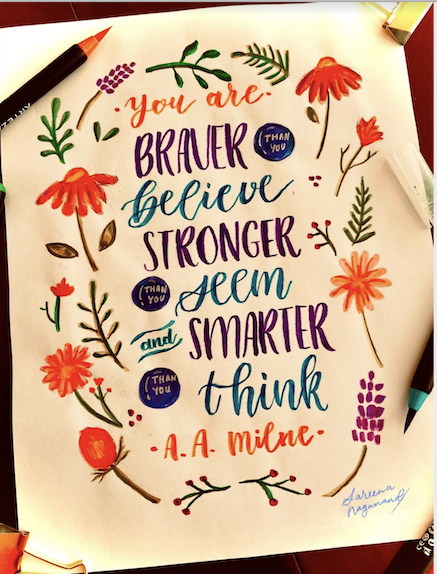The following blog is a winner of the Brainy Blog Competition.
Ever since mankind has learned how to write, it has become a fundamental part of our history — manifesting into an intricate art, in some cases. We see this in historic empires, namely the Islamic Empire, where Arabic handwriting branched into a unique form of Arabic calligraphy and has since been used to spread religious messages. Similarly, calligraphy and brush lettering have been prevalent in Japan and China since the medieval ages. As we approach the modern era, we’ve seen more distinct forms of calligraphy and hand-lettering, such as the classic ‘old English letters’. Personally, hand-lettering has played a major role in my life; it has served as a hobby and a source of therapy. I find the greatest pleasure in bringing ordinary words to life with different strokes and embellishments — as displayed in the image above. Similarly, I am often guilty of redefining my calligraphy style in school notebooks and worksheets.
However, recent observations have proven that practicing hand-lettering has the ability to improve brain function. Specifically, handwriting — and thus hand-lettering — increases language processing skills. The ability to process language is controlled by multiple areas of the brain. For instance, the Broca’s area — located in the frontal lobe of the brain — is linked to speech production and language comprehension. Further, the Wernicke’s area — located in the cerebral cortex — is involved in understanding written and spoken language. In fact, according to a study performed at the Indiana University, the action of writing by hand increases neural activity in these areas of the brain — much like meditation (as shown by high-tech resonance imaging). It also unleashes creativity not easily accessed in any other way.
The reasoning behind these results is substantial. When a person practices handwriting (as supposed to typing), they are taking the time to absorb — and process — what is being written. It is a slower process, and hence a more beneficial one. Handwriting is a complex task that involves multiple visual perception skills such as eye-hand coordination (the ability to coordinate eye movement with hand movement), visual discrimination (the ability to classify objects or shapes based on visual information) and position in space or spatial relationships (the ability to process information about oneself in relation with their environment in space, orientation, and position). Put in more simpler terms, while handwriting requires us to transfer our thoughts on paper, it also requires us to analyze other factors like size, propritions, and spacing; the intertwinement of these two distinct processes is what enhances mental cognition.
Even though these studies are predominantly centered around day to day handwriting, the same findings can be applied to hand-lettering and calligraphy, as well. When creating a hand lettered piece, the same visual perception and planning skills are employed. In the process of transferring a phrase on paper, the artist is forced to consider artistic elements — such as format, fonts, and stroke size. Because more time and effort is utilized in forming calligraphy letters, the resulting phrase is absorbed and processed better; compared to normal handwriting, hand-lettering increases neural activity further. Whenever I need to remember something important, such as a quote, I turn to my brush pens and “calli-grafy” it — doing that seems to store the phrase in my brain for a very long time!
In summary, hand-lettering is an increasingly popular art that has taken numerous forms throughout time. However, this intricate and historic art is sometimes overshadowed by the prospect of typing — which has made transferring thoughts on paper effortless. Nonetheless, hand-lettering has proven to have significant value; while being a form of art and relaxation, it also increases neural activity, improves language processing, and enhances visual perception skills. I have full confidence that as time progresses, hand-lettering and calligraphy will continue to be treasured.
